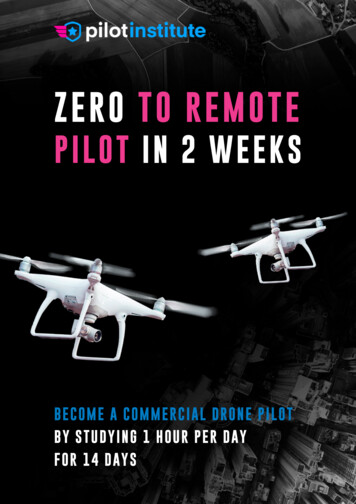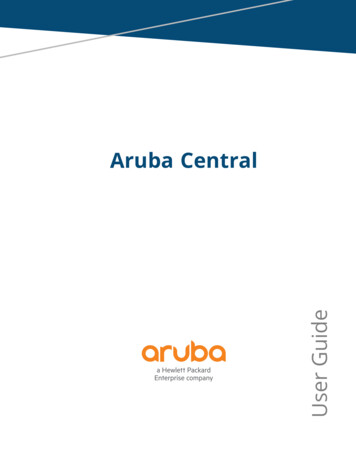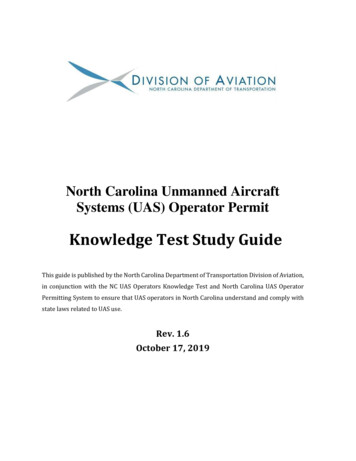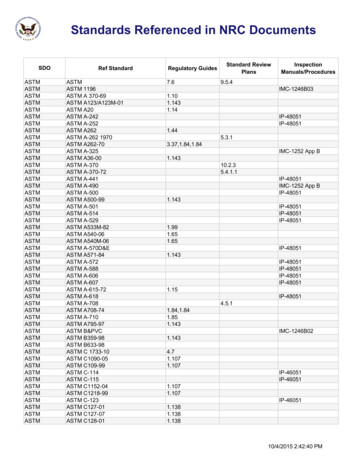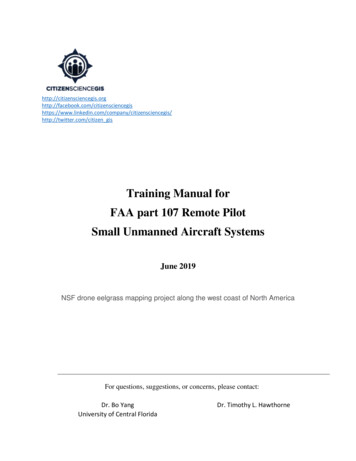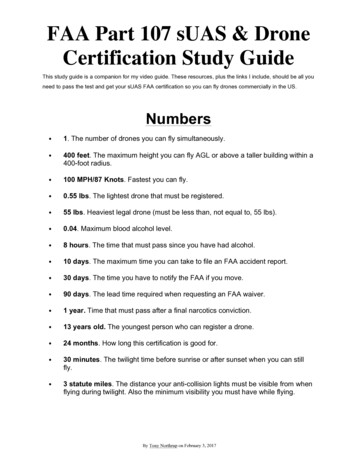
Transcription
FAA Part 107 sUAS & DroneCertification Study GuideThis study guide is a companion for my video guide. These resources, plus the links I include, should be all youneed to pass the test and get your sUAS FAA certification so you can fly drones commercially in the US.Numbers 1. The number of drones you can fly simultaneously. 400 feet. The maximum height you can fly AGL or above a taller building within a400-foot radius. 100 MPH/87 Knots. Fastest you can fly. 0.55 lbs. The lightest drone that must be registered. 55 lbs. Heaviest legal drone (must be less than, not equal to, 55 lbs). 0.04. Maximum blood alcohol level. 8 hours. The time that must pass since you have had alcohol. 10 days. The maximum time you can take to file an FAA accident report. 30 days. The time you have to notify the FAA if you move. 90 days. The lead time required when requesting an FAA waiver. 1 year. Time that must pass after a final narcotics conviction. 13 years old. The youngest person who can register a drone. 24 months. How long this certification is good for. 30 minutes. The twilight time before sunrise or after sunset when you can stillfly. 3 statute miles. The distance your anti-collision lights must be visible from whenflying during twilight. Also the minimum visibility you must have while flying.By Tony Northrup on February 3, 2017
500 feet. Minimum number of feet below a cloud you must fly. 2,000 feet. Minimum number of feet horizontally from a cloud you must fly. 500. The repair cost of accident damage that requires you to report an accidentto the FAA Level 3. The “serious injury” AIS level that requires you to file an accident report. 122.9. The MULTICOM frequency for self-announce procedures. 2000 feet. The distance you should operate from a tower to avoid hitting guywires.Facts Stalls. Occurs when the wing exceeds its critical angle of attack. Center of Gravity (CG) Limits. Supposed to be defined in the Pilot’s OperatingHandbook or UAS Flight Manual, but those don’t exist for drones. Angle of attack. Determines when the craft stalls. This doesn’t change if thevehicle weight changes. Load Factor. Increases during any maneuver. Remote PIC. This is the answer to any question about who is responsible. Left. Aircraft always turn left when circling a runway, because drivers sit on theleft side of the car in the US, and pilots sit on the left of the plane, too. It’s easierfor them to look out the left window to see the tower. Maintenance schedule. You’re supposed to have one, even though mostdrones can’t be user-repaired and don’t provide a schedule. Risk Management. Helps to prevent an accident chain. Personality factors.Machismo. Taking risks to impress others Impulsivity. Doing something without thinking about it. Invulnerability. Thinking accidents won’t happen to you.Page 2By Tony Northrup on February 3, 2017
Resignation. What’s the use? They don’t control their destiny. Anti-authority. Nobody can tell me what to do. Crew Resource Management (CRM). It’s how you manage your “crew” and youshould integrate it into all phases of the operation. Systematically focus on different segments of the sky for short intervals.That’s how you should scan for traffic–let your eyes rest in different areas for awhile, rather than continuously scanning. Latitude is like climbing a ladder (north-south) Longitude is the long way around the planet (the Earth is fat cuz it spins). Standard briefing. Contains the weather forecast. CTAF vs UNICOM vs MULTICOM vs AWOS. AWOS is weather. CTAF is forpilots to talk to each other when there’s no tower. UNICOM is a base station thatbroadcasts to pilots when there’s no tower. MULTICOM is used as the CTAFwhen there’s no CTAF (122.9 or 122.95).Weather Temperature inversion. Warm air on top of cold air. Fog, haze, low clouds, poorvisibility, but smooth air. Moist, unstable air. Turbulence (because the air is unstable), showeryprecipitation. Stable air. Smooth air, poor visibility, and steady (not showery) precipitation(because stable air is usually humid). Unstable air. Intermittent precipitation. Cool Dry Stable Hot Humid Unstable High density altitude. Just means “high altitude”. Air is thinner, so lift isdecreased. Nimbus. Means a rain cloud.Page 3By Tony Northrup on February 3, 2017
METAR Reports 18004KT: Wind is 180 degrees at 4 knots. The first three digits (180) are thecompass heading (180). The last two #s are the wind speed (04). Compass headings are always relative to true North in print, not magnetic North.If it’s in print, it must be true. OVC007: Sky is overcast at 700 feet. Remember, #s are always in hundreds. 1 1/2SM: Visibility is 1 ½ statute miles (SM).METAR Weather AbbreviationsYou don’t need to memorize these, just be able to recognize them and match them toan answer. The test will probably only use the common abbreviations. BLPY Blowing spray IC Ice Crystals BR Mist PL Ice Pellets DS Dust Storm PO Dust/Sand Whirls DU Widespread Dust RA Rain DZ Drizzle SA Sand FC Funnel Cloud SG Snow Grains FC Tornado/Water Spout SN Snow FG Fog SQ Squall FU Smoke SS Sandstorm GR Hail UP Unknown Precipitation GS Small Hail/Snow Pellets VA Volcanic Ash HZ HazePage 4By Tony Northrup on February 3, 2017
CHARTS CTAF (Common Traffic Advisory Frequency) is marked with a C. AWOS is for the weather. Red flags mark VFR checkpoints which mean more planes might be there. Tick marks. Measure minutes between latitude and longitude degrees. Each tickis one minute. Bigger ticks mark 5 minutes. Charts include measurements AGL, not MSL.Controlled AirspaceClass B is the most restricted, class E is the least restricted. Must get ATC (Air TrafficControl) authorization for class B, C, and D.Class A. From 18,000 feet to 60,000 feet, all over the US. Class B. Surrounding major airports, 0-10,000 feet. Consists of multiple layers,like an upside-down wedding cake. Class C. Surrounding airports with a control tower, radar, and over a specificamount of traffic. Usually 5 NM (nautical mile) radius from 0-4,000 feet, and a 10NM radius from 1,200-4,000 feet. Class D. Surrounding airports with a control tower. 0-2,500 feet, no specificradius, just shaped around flight patterns. Outside control tower hours, Class Dairspace is Class G. Class E. Usually it starts at 1,200 feet and goes up to 18,000 feet. Class G. Uncontrolled airspace (below class E airspace).By Tony Northrup on February 3, 2017
Special Use AirspaceAirspace with various restrictions. Prohibited Areas (P-###). Places like Camp David and the White House. Restricted Areas (R-###). It’s not prohibited, but if you fly here, it could be dangerous.The government might be testing artillery or missiles or UFOs.Page 6By Tony Northrup on February 3, 2017
Warning Areas (W-###). Domestic and international waters, from NM outward from theUS coast. It’s cool to fly there it’s just not really managed by the US. Military Operations Areas (MOAs). MOAs consist of airspace with defined limitsestablished for the purpose of separating certain military training activities from IFRtraffic. Whenever an MOA is being used, nonparticipating IFR traffic may be clearedthrough an MOA if IFR separation can be provided by ATC. Otherwise, ATC reroutes orrestricts nonparticipating IFR traffic. Will often consist of multiple Restricted Areas (R###). An example of this is Chocolate Mountain Impact Area (R-2507) and ChocolateMountain Aerial Gunnery Range (R-2507), which we drove through in California.Page 7By Tony Northrup on February 3, 2017
Alert Areas. Depicted on aeronautical charts with an “A” followed by a number (e.g., A211) to inform nonparticipating pilots of areas that may contain a high volume of pilottraining or an unusual type of aerial activity. Think skydiving training facility.Chart-Reading Tips Numbers (like 41/12) are written in 100s of feet above sea level (MSL). So, 41/12means 4100 ft, 1200 ft. SFC Surface Let’s make this simple. Ladder sounds kind of like latitude. You climb theladder going north. (Keep in mind it is north only if you are in the NorthernHemisphere) For minutes, just think of them as tick marks. There is a box with 30tick marks in it, a line, and then another 30 tick marks. Total you get 60 minutes.For longitude, also called meridians, think of the Prime Meridians running throughGreenwich, England. Why is this useful? To figure out if the coordinates of thepotential job site are in airspace which requires a COA. I use coordinates all thetime when I’m working with my clients to figure out if they need a COA or not. Download your local chartsHelpful video: Airspace visualizationsHelpful video: Reading FAA chartsPage 8By Tony Northrup on February 3, 2017
AcronymsThis is just for reference while you’re studying, you don’t need to memorize these. AC: Advisory Circulars MSL: Mean Sea Level ADM: Aeronautical Decision Making MTR: Military Training Routes AFM: Aircraft Flight Manual MULTICOM: Not an acronym, just AGL: Above Ground Levelthe radio frequency (122.9) we use AIM: Aeronautical Informationto announce aircraft when there’s noManualATC. AIS: Abbreviated Injury Scale NAS: National Airspace System ASL: Above Sea Level NM: Nautical Miles ASOS: Automated Surface NOTAM: Notice to AirmanObserving System (monitors the NTAP: Notice to Airman Publicationweather) NTSB: National Transportation ATC: Air Traffic ControlSafety Board ATCT: Air Traffic Control Tower NWS: National Weather Service ATIS: Automatic Terminal OVC: Overcast (from METAR)Information System (a loop of useful PIC: Pilot In Control. You, flying theinformation broadcast over the radiodrone.near an airport) POH: Pilot Operating Handbook AWC: Aviation Weather Center RA: Rain AWOS: Automated Weather SFC: SurfaceObserving System SIDA: Secure Identification Display CFR: Code of Federal RegulationsArea. The part of the airport where CG: Center of Gravityyou need to be wearing a badge. CoW: Certificate of Waiver SM: Statute Miles CRM: Crew Resource Management SMS: Safety Management System CS: Control Station (your remote sUAS: Small Unmanned Aircraftcontrol)Systems (aka., drone, UA, UAS) CTAF: Common Traffic Advisory TAF: Terminal Aerodrome ForecastFrequency TFR: Temporary Flight Restriction FAA: Federal Aviation UA: Unmanned Aircraft (aka., drone,AdministrationsUAS, UAS) FDC: Flight Data Center UAS: Unmanned Aircraft System FLIP: Department of Defense Flight(aka., drone, sUAS, UA)Information Publication UNICOM: Not an acronym: FL: Flight LevelUniversal Communications. A radio FSS: Flight Service Station.broadcast that tells you about nonProvides pilot briefings, enrouteflight services, such as fuel, taxis,communications, search-and-rescueand car rentals.services, help lost aircraft, etc. VFR: Visual Flight Rules FTP: Flight Termination Point VLOS: Visual Line-of-Sight IFR: Instrument Flight Rules VO: Visual Observer ILS: Instrument Landing System VOR: Very High Frequency LOA: Letter of AgreementOmnidirectional Range. They’re METAR: Aviation Routine Weathernavigation beacons.Reports VR: Visual Flight Rules Military MOA: Military Operations AreaTraining RoutesPage 9By Tony Northrup on February 3, 2017
Free Practice Tests 3DR’s excellent sample test. This test has great explanations for the official FAAsample test.Rupprecht Law’s sample test. Also includes detailed explanations.Part107.org sample test. Yet another take on the official FAA questions.Taking the TestWhen you’re ready to take the test, call the test coordinator, not the testing center. The FAA liststwo services. I used CATS: Computer Assisted Testing Service (CATS): 1-800-947-4228 PSI / LaserGrade Computer Testing: 1-800-211-2753When you call them, the process is:1. You give your name, birth date, birth location, address, etc.2. You tell them when and where you want to take the test.3. They call the testing center, which is probably some small office located next to a smallairport. They need to talk to the actual proctor who administers the test, so if they’re onvacation, you can’t schedule your test. I called twice to schedule a test at my closesttesting center, but the proctor wasn’t personally available either time, so I gave up andscheduled my test further away at a center where the proctor actually answered thephone.4. They charge your credit card 150.5. They confirm your testing time and send you an email with the testing location anddetails.You’ll get about 60 questions on your test. My test had 64, but it’s possible that 4 of thosequestions were ungraded questions that were added to my test to see if they were meaningfulquestions.You need 70% to pass, so you can miss about 18 questions and still pass. All questions aremultiple choice with three options (A, B, C) so even if you have to guess, you have a 33%chance of getting it correct.Therefore, statistically, you can probably still pass if you have to guess on 27/60 questions.However, of the three possible answers, one of them can almost always be quickly eliminatedas a possible option because the answer is just stupid. Therefore, if you are unsure about aquestion, use logic to eliminate one of the answers, and give yourself a 50/50 chance ofguessing correctly. If you can do that, you can guess at 36/60 questions and still pass.So, you only need to be confident about 40% of the questions, and 40% of the questions aredefinitely really, really easy. Indeed, 88% of testers pass, and this was the easiest certificationtest I’ve ever taken.Page 10By Tony Northrup on February 3, 2017
I recommend showing up to the test 30 minutes early and reviewing your notes, so theinformation is fresh in your mind.Lock your phone in your car, because you can’t bring electronics into the test. Use the restroombefore you go into the test, because they don’t want you to leave.You need to bring: A valid photo ID (like your driver’s license)That’s it. The FAA tells you to bring a simple four-function calculator, but my proctor offered toloan me a calculator, and my test didn’t have any questions that required any math. So youprobably don’t need to bring the calculator.You’ll take the test in a private room sitting on an outdated computer with a dirty mouse andkeyboard and a webcam pointed at you, recording everything you do. There might be otherpeople taking tests at the same time.Some testing tips: You have two hours. That’s 2 minutes per question. It only took me about 45 minutes.You can increase the font size in the testing software.You can go back and change the answer to any question, until you choose to finish yourtest.If you’re unsure about any question, take your best guess, and then click the Markbutton. Marked questions show up in the index with a question mark.Before you submit your final test, carefully review all your marked questions. Use theprocess of elimination to reduce the possible answers.When you submit your test, you’ll see your score immediately. You’ll almost certainlypass it, because you’re reading this study guide, which means you’re taking it seriouslyand preparing and the test is really easy.They’ll give you some stuff to take into the test with you: A pencilA bunch of blank paperThis booklet (don’t write in it)Maybe a calculator if they want to loan one to you, but they’re not required to do thisAfter You’ve PassedThe proctor will print out a sheet of paper with an official stamp that includes your test score, alist of the questions you missed, and a test ID. When you get back to your smartphone, take apicture of this paper, because it has the Exam ID you need and you don’t want to lose it.Page 11By Tony Northrup on February 3, 2017
YOU’RE NOT YET CERTIFIED. This is the government, so you have more paperwork to do.You need to:1. Create an FAA account.2. Submit an application that includes your Exam ID.3. Wait 7 days for the FAA to email you a temporary certificate. You can now fly with thattemporary certificate.4. Wait longer for the TSA to do a background check on you and mail you your officialcertificate.Wait 48 hours for the FAA to receive your test results, because even computer test results travelslower than snail mail. Don’t wait more than 10 days, however, or your test results will expire.So, 2-10 days after you pass your test, visit http://iacra.faa.gov. Click the Register link and setupan account for yourself.Click the Start New Application button, and fill in all the info.The form has a pretty weird user interface at the bottom there are three buttons, and you’llneed to agree to terms and review a privacy agreement before you can review your application.After you review it, you need to officially submit it. It would be easy to think you were donesubmitting the form without actually submitting it, so be sure you actually submit it.When you’re done, your FAA Applicant Console should look like this:Page 12By Tony Northrup on February 3, 2017
YOU’RE NOT YET CERTIFIED. You can’t legally fly commercially until they email you atemporary certificate.What if you FailBefore you leave the testing center, you can take a few minutes to review the questions you gotwrong not the answers, but the questions. Do that so you know what to study up on.The testing center also gives you a paper listing every question you got wrong. The codes looklike PLT124, PLT161, PLT173. You can look up what the codes mean here and link to theofficial FAA documentation for every question, which should have the answers you’re looking for(and WAY more). They don’t give you the actual question, but just the area of knowledge.You can take the test in another two weeks you’ll have to pay the 150 fee again, however.One More Thing We’re giving away this study guide and video training material, but it definitely wasn’t free for usto make. To help us out, you could: Subscribe to our YouTube channel. Visit that link and click Subscribe. It’s free, andwe bring you several new drone & photography videos every week. Watch our free drone videos. We teach you how to safely fly a drone, how to use cool3D mapping software, and give you drone reviews to pick the best UAS. Check out our photography & post-processing video books (at Amazon or ourstore). They’re 10, and watching/reading them will do WAY more to improve your aerialimagery than any hardware upgrade.And please share this with your friends! Good luck!Page 13By Tony Northrup on February 3, 2017
FAA Part 107 sUAS & Drone Certification Study Guide By Tony Northrup on February 3, 2017 This study guide is a companion for my video guide. These resources, plus the links I include, should be all you need to pass the test and get your sUAS FAA certification so you can fly drones commercially in the US. Numbers
